This Remote U.K. Island Is Home to a Rare Breed of Wild Ponies and a 13th-century Castle Where You Can Spend the Night
- Oops!Something went wrong.Please try again later.
Lundy Island, located in the Bristol Channel, is the perfect place to explore the U.K.'s beautiful natural scenery.
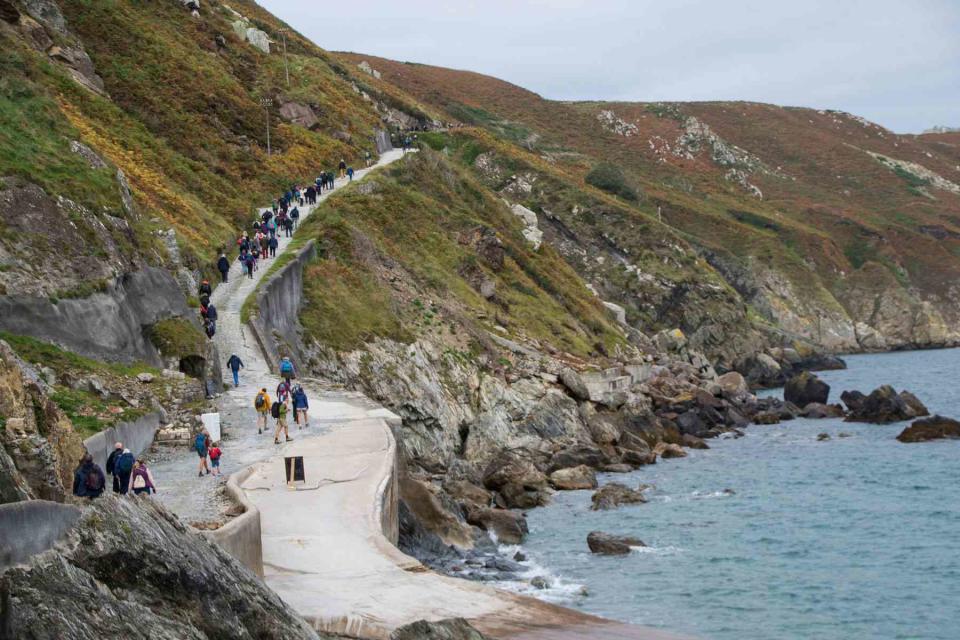
Jason Jones/Getty Images
"It is a bit of a squeeze in there," the heliport steward says, prepping us for the helicopter." There isn't much room for feet." We are sitting at the Lundy heliport, in a waiting room building that strangely resembles a scout hut. The walls are plastered with informative conservation boards — details on a zero-rat policy to protect seabirds like Lundy's beloved puffins, an explanation on the migration pattern of sharks, and, of course, a tiny section dedicated to the Lundy ponies. Looking around at the 40 or so people waiting for a helicopter, you quickly begin to wonder which factor most drew them to this remote British island. Are they intrigued by the ponies as well?
Groups of six are filed out at a time, ushered in single file toward the open chopper door. Helicopter five has boarded and gone; we are number six.
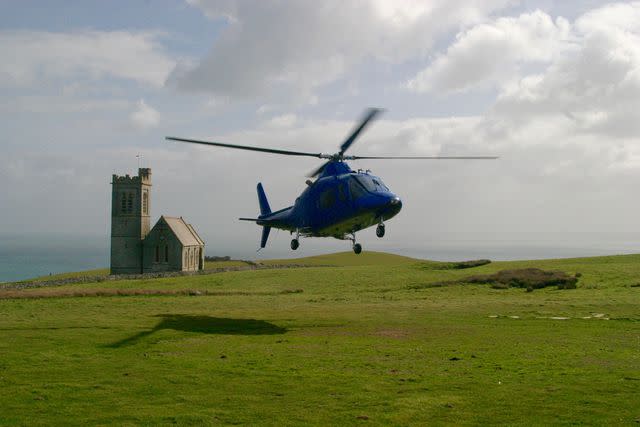
Teri Symons/Getty Images
Helicopter six is called, and we dutifully rise. The luggage building is ready to weigh our bags. With just six people in the queue, boarding takes five minutes, and after a quick refuel, the Lundy helicopter is ready to go. A minute or two passes, and we are strapped in as well. I am wearing a designated "headset passenger" to communicate with the pilot up front. The helicopter lurches forward and rises up into the air. Just six minutes later, we cross the channel and land on Lundy Island, ready and raring to track the island's rare breed of wild horses.
The Lundy ponies were introduced in 1928 as a private conservation project of former island owner Martin Coles Harman. Shipping 42 New Forest mares and fillies from the mainland, he allowed the animals to roam the island as they wished. Then, in 1930, he brought in a Welsh Mountain stallion, strawberry roan in color. One of the stallion's sons, a dun-colored pony named Pepper, much resembled the animated character of Spirit of the Cimarron and took his father's place leading the herd. It is thanks to Pepper, I'm told, that there's such a long line of dun ponies on the island.
Harman lived in peace and prosperity with his herd of wild ponies. The only pony-related mishap was when there was a slight overpopulation during Word War II, when excess ponies could not be shipped over the mainland. Lundy's story only changed when Harman's son, Albion Harman, died in 1969. There was much anxiety over who would take over Lundy's legacy, with no owner left in line. Fortunately, the National Trust took on the island, and The National Pony Society assumed the responsibility for the future of Lundy ponies. The rest, as they say, is history.
On my visit, with a thick coat to fight the December breeze, I walk straight from the heliport landing through the village and toward the quarter wall — the spot that the ponies are rumored to prefer.
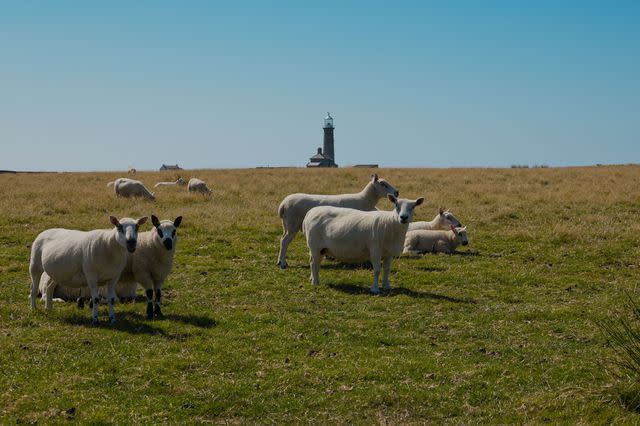
Paul Hayward/Getty Images
I stumble across a group of five ponies immediately after opening the old metal gate that divides the village and wilderness. Looking at them apathetically grazing despite me standing mere feet away does beg the question of just how wild these ponies are. Almost to affirm my thoughts, a dun mare with one blue eye and one brown eye looks at me and slumps to the ground for a nap. Her attitude is infectious, and I sit with her on the floor, scratching her neck and observing the other mares. The three bays and other dun look fairly old, although in good health. The Lundy ponies have no natural predators and are accustomed to hikers, so their laid-back attitudes make sense, especially at the twilight age of 20-plus.
Toward the coast, I make my way down a flight of muddy stone steps, noticing hoof prints that prove the ponies have previously succeeded in scaling the same stairs. The sure-footedness of the herd is admirable. Further along the grassy cliffside track, adorable mountain goats with beards and curled horns peek over the edge of boulders. However, the goat photo shoot I'm tempted to have is disrupted before it can even begin by a shrill shriek. Startled, my head shoots up to see a herd of Japanese sika deer observing me from atop the cliffs, about a hundred meters above. The whole scene feels very "Bambi"-esque. Harman clearly had an eclectic taste in wildlife.
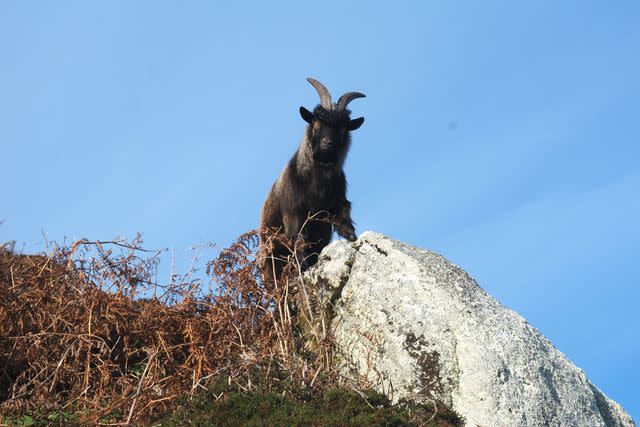
Eibhlis Gale-Coleman
The rest of my hike is rather unsuccessful as far as pony sightings go. I see ravens so big, I mistake them for people on a distant cliff. There's a herd of highland cattle, too, and a few more deer shrieks — although none reappeared, so they must have been observing me from some hidden spot. After looping the entire headland, I arrive back at the gate and, ironically, here stands the remainder of the herd. Clearly, these are the youngsters and middle-aged mares. The herd dynamics are a little more tense, with different mares taking turns to push the other horses around in displays of dominance. I make a quick mental note to avoid teeth and feet.
A little dun colt spots us and curiously marches straight up with his ears pricked forward as a friendly "hello." As the first male pony I've spotted, he seems sweet and much more willing to actively engage and seek out human company. Our interaction does not last long, though, as a strawberry roan mare walks up and bites him on the bum — a clear message to move on and stop talking to this strange woman. She doesn't seem interested in meeting me, either. On the other side of the herd, a little bay mare approaches. She, again, is curious and friendly, putting her nose up to my face to smell me. We get around a minute of interaction before the strawberry roan mare returns with her ears pinned back. She moves on the little bay, then gives me a sour look. I know my time is up. "Hint taken," I tell her and begin my walk back to the village.
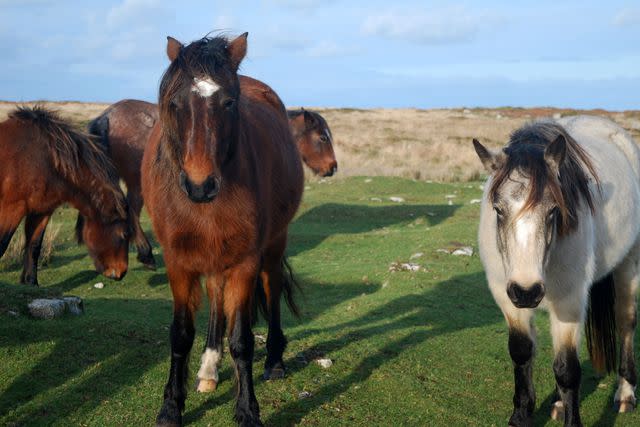
Eibhlis Gale-Coleman
By now, I've been hiking and spotting the herd for three hours, and my stomach is starting to grumble. The 19th-century Marisco Tavern is calling with the promise of fish and chips and a fresh pint of Cornish pale ale. While I wait for my food, I spot a large blue folder entitled "Lundy Ponies — Sponsorship." It has pictures of every pony on the island, plus all of their details, including name, birth date, and breeding lineage. The friendly dun colt was called St. John, and the little bay mare was Fiona. The boss — a.k.a. the strawberry roan mare — was Tibbets Anne, born in 2019. Reading about the ponies with a refreshing drink and a full stomach is a nice touch.
If you visit Lundy Island between April and September, you have the option of a ferry to take you back to the mainland. However, this is December, and in December, no ferries dare navigate the channel and jagged Lundy coastline. Instead, I'm cut off from the mainland for three days when the next helicopter is scheduled on Monday. In the meantime, I plan to stay in a 13th-century castle commissioned by Henry III as a base to stop a Lundy Island uprising in its tracks. It's quite an exciting accommodation option, although I'm apprehensive considering the electricity gets cut off between midnight and 6 a.m. I ask the bartender how to check in. "Just walk out of the pub and turn left," she says. "The keys are in the door, and it's the big castle — you won't miss it".
Monday seems like a long time away, and I don't doubt that I'll be returning to spend time with the herd tomorrow. Perhaps I'll be able to befriend Tibbets Anne in that time. Or maybe not. She has a job to do, and for now, our friendship seems a little one-sided.
For more Travel & Leisure news, make sure to sign up for our newsletter!
Read the original article on Travel & Leisure.

